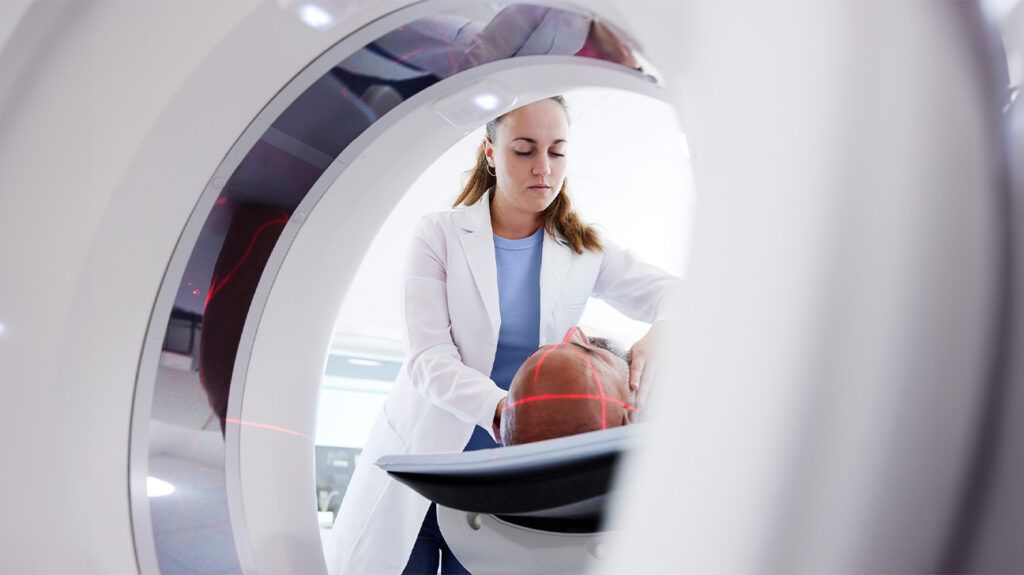PET scans can light up tumors in the body and help doctors determine if they are cancerous or benign (noncancerous). The results of a PET scan help guide medical decisions.
A PET scan is a type of imaging test that helps doctors locate tumors, understand their type, determine their size, and decide on the most appropriate treatment.
This article will review how doctors use PET scans to detect benign tumors, what a person can expect before, during, and after a PET scan, and what the results can show.

A PET scan can do the following:
Doctors
Some hospitals may also have a PET/MRI scan, which combines the diagnostic properties of a PET scan with the qualities of MRI scans in assessing soft tissues in the organs such as the brain, liver, and pelvis.
What is a PET scan?
A positron emission tomography (PET) scan is an imaging test that
To perform a PET scan, doctors inject a person with a radioactive chemical known as a radiotracer. This chemical allows atypical cells to light up under the PET scanner, as these cells tend to absorb a more significant amount of radiotracer.
Learn more about PET scans.
What are benign tumors?
The human body can sometimes
Benign tumors consist of a group of cells that multiply too quickly or do not die off when they should. Unlike cancer, benign tumors grow slowly, have smooth edges, and do not spread to nearby tissues or travel to other body parts.
Doctors can usually completely remove benign tumors, and they rarely come back. However, these tumors can get quite large. In some cases, such as when a benign tumor develops in the brain, they can cause serious problems or even be life threatening.
Learn more about benign tumors.
PET scans show the areas in the body where cells have more activity than usual. This may be a sign of a health condition, including cancer.
The scan
A PET scan can also show the size and shape of tumors and whether they have spread, helping doctors determine whether the growth is benign or cancerous.
Benign tumors
PET scans do not require hospitalization, so a person who has this kind of test can go home on the same day.
A doctor may give the person some instructions about what to do to prepare for a PET scan, including:
- not eating for 6 hours beforehand
- avoiding strenuous exercise for 24 hours
- wearing loose, comfortable clothing to the scan
- not wearing jewelry or other accessories or clothing with metal parts
The person will need to tell the healthcare team if they have any allergies to ensure the contrast agent is safe for them.
People may also wish to let the team know if they become highly anxious in enclosed spaces, as the scanner is a like a large cylindrical tunnel. A person may be able to receive a mild sedative to help them relax during the scan.
If the person is nursing or thinks they may be pregnant, they should speak with a doctor before undergoing this procedure.
Before the scan starts, a healthcare professional will give the person an intravenous radiotracer injection. It takes about 1 hour for the radiotracer to reach the bloodstream.
At this point, once the tissues and organs are starting to absorb the radiotracer, a specialist called a radiographer can begin performing the PET scan.
The person lies on the PET scanner’s sliding table and moves toward the scanner tunnel. The scan usually lasts 30 to 60 minutes, during which the person needs to remain still.
The PET machine makes clicking and buzzing noises while it is working. When the scan finishes, the radiographer reviews the images to ensure they are in focus before the person leaves.
After the scan, a person can go home and start drinking and eating normally. It is important to drink plenty of fluids to help flush the radiotracer out of the body.
While a person receives a very small amount of radiation during a PET scan, it is best they avoid close contact with babies, young children, and pregnant people for a few hours after the scan.
If someone receives a mild sedative to help them relax during the test, they will need to arrange transportation home after as they will not be able to drive.
After a PET scan, the radiologist will share the findings with the other healthcare professionals in charge of the person’s care. The test results are not immediately available and may take a few days or weeks to arrive.
PET scans can detect tumors in the body and determine if they are cancerous or benign. A PET scan can also show the size and location of a tumor to help doctors determine the most appropriate treatment.
A PET scan may take a couple of hours, as the doctor has to inject the person with a radiotracer and wait for about an hour to ensure the tissues around their body absorb it. However, this is an outpatient procedure. People can go home the same day of the scan.
